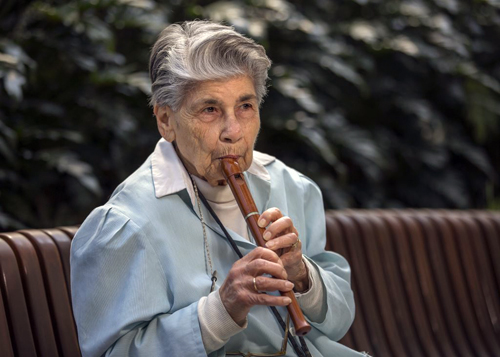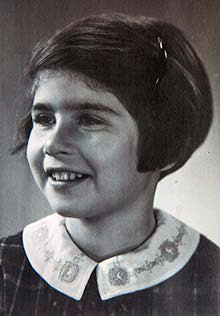
LOS ANGELES (Press Release) – Ruth Moll was the second of three girls from a middle-class family in Stuttgart, Germany, during the 1930s.
Her older sister, Hannah, was the “bossy” one as Ruth, now 89, put it recently, breaking into a wry smile. Her younger sister, Ellen, was “very bright.”
And Ruth, in the particular dynamics of her family, was the “emotional” one. Over the years, she would become many things — a wife, a mother and a Cedars-Sinai volunteer for more than two decades.
“My mother could never understand why I cried so much,” said Ruth, who speaks with a soft voice and a German accent. “I couldn’t help it.”

There was a lot to cry about in those early years. Not the least of those reasons came on Feb. 2, 1939. On that winter’s day, 10-year-old Ruth and her sisters each packed a small suitcase, said goodbye to their mother — perhaps forever — boarded a German train and embarked on a bewildering journey over land and sea that ended in Great Britain, a place they had never been, where they knew no one and where they didn’t speak the language.
Despite the upheaval, Ruth realizes today, she and her sisters were among the lucky ones — Jewish children who escaped Nazi Germany. They were saved by the Kindertransport (German for “children’s transport”), a series of rescues organized by the British over a two-year period that spared about 10,000 children from the Holocaust.
On Friday, Ruth will take a break from her volunteer duties to participate in Cedars-Sinai’s 33rd annual Yom Ha’Shoah observance. As she has for many years at the ceremony, she will once again be part of a select group to light candles for the 6 million European Jews who were killed by the Nazis.
“I’m honoring the memory of everybody who passed away,” said Ruth, whose maiden name is Schmidt. “I have some who passed away during the war, but I also do it for my husband, may he rest in peace. He lost family during the war.
“I get emotional inside about the lighting of the candles,” she added. “It’s important to me to do it.”
A Jewish Child Inside Nazi Germany
In 1933, about 520,000 Jews were living in Germany when Adolf Hitler rose to power. Over the following years before the outbreak of World War II, about 304,000 Jews were able to emigrate, according to figures from the U.S. Holocaust Memorial Museum.
Even as late as 1938, however, it seemed unlikely that Ruth’s immediate family would be among those to flee Germany, a country her family had called home for generations. Her grandfather owned a factory in Stuttgart, a large industrial city in southwestern Germany. Her father was determined not to abandon the family business, which produced men’s underwear and employed about 100 workers, both Christian and Jewish.
In those pre-war years, Ruth was only vaguely aware of the deteriorating and increasingly dangerous situation for German Jews. “We were kept away from politics, being Jewish and all that business,” she said.
But in November 1938, “Kristallnacht,” often referred to as the “Night of Broken Glass,” set into motion Ruth’s flight from her native country. Over two-days of rioting and violence, Nazis burned synagogues, looted Jewish businesses, vandalized Jewish cemeteries, and randomly beat and killed Jews. Ruth remembers being prevented from attending school, losing her non-Jewish friends and seeing “Jews Forbidden” signs across the city.
Gestapo at the Door
One night the Gestapo knocked at her family’s front door at 12 Werfmershalde in Stuttgart. The German secret police said they were looking for guns — and Ruth’s father, Walter. They found neither, but before finally leaving, they confiscated the family’s Jewish books and texts.
“They told my mother that if my father didn’t turn up, they would take her instead,” Ruth said.
The Gestapo eventually caught her father and threw him into a concentration camp. Ruth doesn’t remember how her father’s absence was explained.
Getting Out of Germany
During this tumult, Ruth’s parents had arranged for their daughters — ages 12, 10 and 9 — to leave the country via the Kindertransport. The program granted temporary travel documents for children under 17, allowing them to enter the United Kingdom, with the assumption that they would rejoin their parents when the crisis ended.
Even today, Ruth doesn’t know how her parents managed the children’s passage to England. What she does remember is the frenzied exodus from Germany.
Ruth’s mother, Dora, gathered the children and told them they would be traveling together to England where they would be able to continue their education and be safe. The children were to pack a single overnight bag, nothing more. They would be leaving immediately.
How long would they be gone? Where exactly would they be going? Who would watch over them? Why weren’t the parents going? When would they see their mother and father again?
There was no time for such questions.
“We all couldn’t understand what was going on,” Ruth said. “It was rush, rush, rush.”
Ruth packed her small bag, mostly with clothes for her new school. She also tucked in her favorite musical instrument, a wooden recorder. She loved to play children’s songs on the recorder. She still has it, in excellent condition in its original case.
“I can’t tell you why I decided to take it at the time, but it meant something to me,” she said.
Tearful Farewells
Ruth’s mother made her tearful goodbyes to the girls at their home. The family’s longtime maid accompanied the children to the Frankfurt train station, where the Kindertransport journey was to begin.
“My mother said she and my father would see us again, but she didn’t know,” Ruth said. “She hoped, of course, but she didn’t know.”
It’s still unclear to Ruth why her mother didn’t accompany the children on the roughly 125-mile trip from Stuttgart to Frankfurt.
“Today, I can see why she didn’t want to come,” Ruth said. “I think she knew it would be too emotional.”
The scene at the Frankfurt train station, where hundreds of families separated, was heartbreaking. For many of the Kindertransport children, the train station goodbyes would be the last time they would see their parents.
“As we finally left the Frankfurt train station, there was a lot of crying and shouting from the other children until the parents were finally out of sight,” Ruth said. “It was terrible.”
On to England
Ruth’s train took her to the Dutch coast, where the Kindertransport children boarded an overnight ferry to England. The churning waters of the English Channel sickened many of them, but by morning the boat landed in Harwich, England. It was Feb. 3, 1939, only months before the outbreak of World War II.
Ruth and her sisters were met by a distant cousin and immediately taken to a Christian boarding school in southern England. School officials split up the German sisters, the only Jews at the school of about 100 students, placing them in separate dormitory rooms to encourage them to learn their new language more quickly.
“English was difficult,” Ruth said. “I even had elocution lessons, but I never lost my accent.”
Months later, weeks before the war started, Ruth’s parents made it to England. Ruth still doesn’t know how.
Unfortunately, despite finally being in the same country again, the family still wasn’t able to come together. Ruth’s father, like many German refugees, was interned by the British, who feared that foreign newcomers might aid a possible Nazi invasion of the English mainland. Ruth’s mother was forced to live for a time with other refugees in a hostel, and was barred from working.
About a year later, Ruth’s parents were able to visit their daughters at their boarding school. Naturally, the brief reunion was very emotional, though Ruth remembers her father being upset at first that his daughters were speaking English.
During the war years, Ruth’s family continued to be separated, but they generally knew where one another were and came together as much as possible. Ruth vividly recalls being huddled with her mother and sisters in underground shelters in London during heavy German bombing known as the Blitz.
“I guess I was crying and I’ll never forget my mother was so upset,” Ruth said. “I told her I didn’t mean to, it just happens. Even to this day, if something unpleasant is happening, tears come to my eyes without me doing anything. It’s emotional for me.”
She paused, then added: “In today’s world, it’s OK to be emotional, but back in that world it was not.”
To America
In the 1950s, Ruth and her younger sister sailed on the Queen Mary to America. They ended up in California, where Ruth met her husband, Rudy Moll, who also was a German Jewish child saved by the Kindertransport. The couple settled in Los Angeles and raised two sons, one of whom lives near Ruth today.
About 22 years ago, Ruth found herself without work and wanted to do something. A friend told her about Cedars-Sinai.
“I came in for the interview, and I’m still here,” she said with a chuckle.
Twice a week, typically Wednesdays and Fridays, Ruth works a full day, usually at the Volunteer Services desk. With her reading glasses on a silver chain swinging from her neck, she greets visitors, answers phones, handles the mail and basically “helps anyone that needs help,” she said.
“I like the camaraderie around here,” she said. “I’m a people person.”
It is for her people that she wants to keep the memory of the Kindertransport alive. Her husband and her sisters — Hannah worked as a teacher, Ellen became a biochemist — all have passed away. Each year, there are fewer voices to tell the story of the 10,000 rescued children.
“It hurts me that people just don’t know about the Kindertransport,” she said.
“I’m old now and it’s sad to see. But thousands were saved by England. Thousands of children.”
*
Preceding provided by Cedars-Sinai Hospital